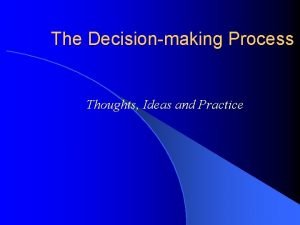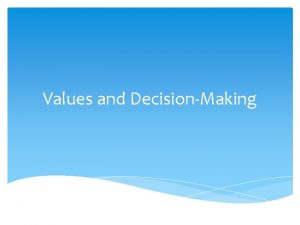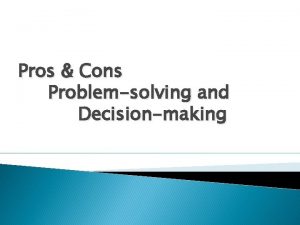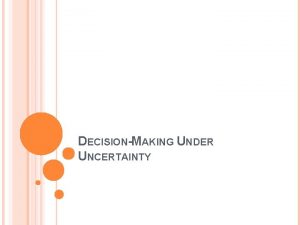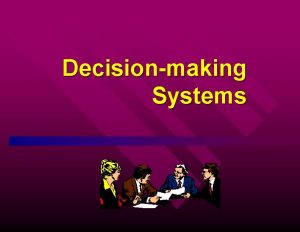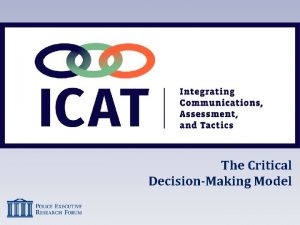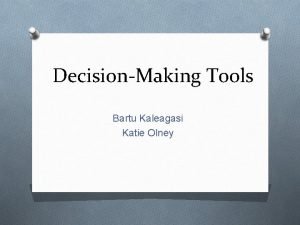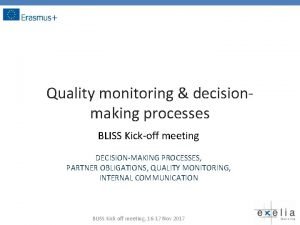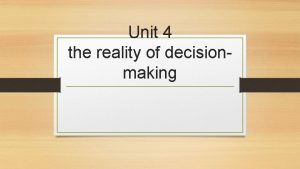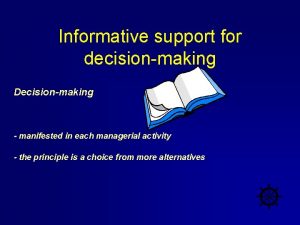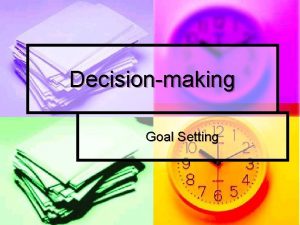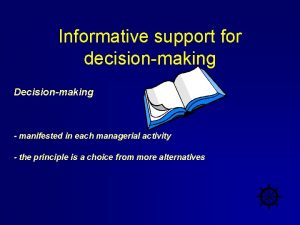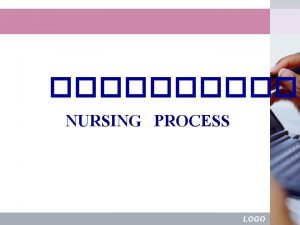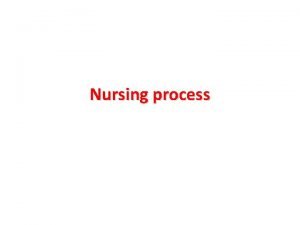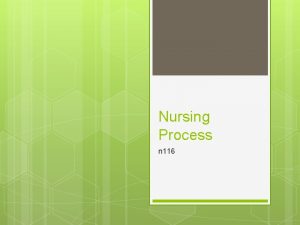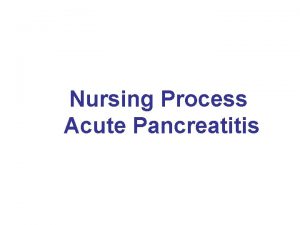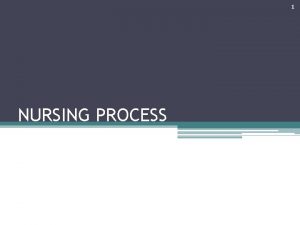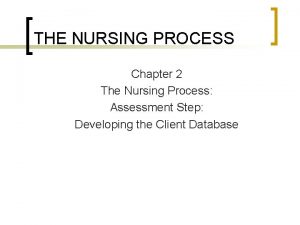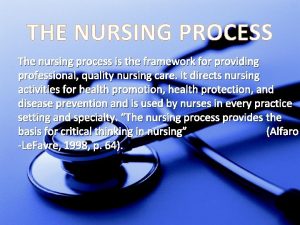The Nursing Process The Nursing Process A decisionmaking




































- Slides: 36

The Nursing Process

The Nursing Process A decision-making method used by nurses for clinical care Influenced by the following 3 elements: Intuition Expertise Critical thinking

The Nursing Process 6 steps: Assessment Diagnosis Outcome identification Planning Implementation Evaluation

Assessment

Assessment Phase in which the nurse collects enormous amounts of data about clients’ holistic health status Nurses collect data through interactive and interviewing skills and observations of verbal and nonverbal behavior Data obtained from this phase enables nurses to prioritize treatment planning according to clients’ needs or immediate conditions

Assessment Includes the Following Criteria: Physical Psychiatric Psychosocial Mental status Developmental Cultural Spiritual Sexual

Components of Mental Status Assessment Appearance Dress, grooming, hygiene, cosmetics, apparent age, posture, facial expression Behavior/Activity Hypoactivity or hyperactivity, rigid, relaxed, restless or agitated movements, gait and coordination, facial grimacing, gestures, mannerisms, passive, combative, bizarre

Components of Mental Status Assessment Attitude Interactions with the interviewer: cooperative, resistive, friendly, hostile Speech Quantity: poverty of speech or content; hyperverbal or excessive Quality: articulate, congruent, monotonous, talkative, repetitious, spontaneous, confabulations, tangential, circumstantial, pressured Rate: Slowed, rapid

Components of Mental Status Assessment Mood and Affect Mood: sad, fearful, depressed, angry, anxious, ambivalent, happy, ecstatic, grandiose Affect: appropriate, apathetic, constricted blunted, flat, labile, euphoric, bizarre Perceptions Hallucinations, illusions, depersonalization, derealization, distortions

Components of Mental Status Assessment Thoughts (Form and Content): logical vs illogical, loose associations, flight of ideas, blocking, broadcasting, neologisms, word salad, obsessions, ruminations, delusions, abstract vs concrete

Components of Mental Status Assessment Sensorium/Cognition Levels of consciousness, orientation, attention span, recent and remote memory, concentration; ability to comprehend and process information; intelligence

Components of Mental Status Assessment Judgment Ability to assess and evaluate situations, make rational decisions, understand consequences of behavior, and take responsibility for actions Insight Ability to perceive and understand the cause and nature of own and others’ situations

Components of Mental Status Assessment Reliability Interviewer’s impression that individual reported information accurately and completely

Components of the Psychosocial Assessment Stressors Internal: Psychiatric or medical illness, perceived loss of self-concept/self-esteem External: Actual loss—death of a loved one, divorce, lack of support systems, job or financial loss, retirement, dysfunctional family system

Components of the Psychosocial Assessment Coping Skills Adaptation to internal and external stressors; use of functional, adaptive coping mechanisms and techniques; management of ADLs Relationships Attainment and maintenance of satisfying, interpersonal relationships congruent with developmental stage

Components of the Psychosocial Assessment Cultural Ability to adapt and conform to prescribed norms, rules, ethics, and mores of an identified group Spiritual Presence of self-satisfying value-belief system that the individual regards as right, desirable, worthwhile, and comforting

Components of the Psychosocial Assessment Occupational Engagement in useful, rewarding activity, congruent with the developmental stage and societal standards

Age Considerations Elderly RN should be alert to physical limitations Hearing, vision, memory, medical conditions Children Use of story-telling, dolls, drawing, can be useful in assessing painful or sensitive areas

Age Considerations (cont) Adolescent Ensure confidentiality Assess risk factors—HEADSSS H—home environment E—Education A—Activities D—Drug, ETOH, or tobacco use S—Sexuality S—Suicide risk S--Savergy

Assessment The Nurse-Client Interview Most critical process involved in gathering data r/t the overall health status of clients with psych d/os When assessing the mental status, the primary “tool” of evaluation is the nurse interviewer The success of the interview depends on the development of trust, rapport, and respect between the nurse and client

Components of the Nurse. Client Interview Presenting Problem Present Illness Family Hx Childhood/Premorbid Hx Medical Hx Psychosocial/Psychiatric Hx Recent Stressors/Losses Education Legal

Components of the Nurse. Client Interview (cont) Marital Hx Social Hx Support Systems Insight Value-Belief System (Including Spiritual) Special Needs (Including Cultural) Discharge Goals

Verifying Data Family/friends may verify or contradict client’s actions Old charts Lab reports Drug screen

Nursing Diagnosis

NSG Dx Formulated after interpreting the data that was gathered in the assessment phase Involves the application of standardized labels to clients’ health problems and responses to illness and life events

3 Components of a NSG Dx Actual Problem Part 1 NSG Dx Sleep Pattern Disturbance Part 2 Etiologic factor (s) (related to) Depression Part 3 Defining Characteristics Complaints of SCD, DFA, EMA

Outcome Identification

Outcome Identification After identifying signs and sx in the assessment phase, outcomes that the client should meet are established Example: Nsg Dx: Violence, risk for; self-directed Outcomes: Verbalizes absence of suicidal intent

Outcome Identification (cont) Nurses must be able to measure and document pt outcomes influenced nsg care

Planning

Planning The process of planning includes the following: Collaboration with clients, significant others, and treatment team members Identification of priorities of care Identification of nsg interventions that will help the pt meet the outcome criteria

Planning (cont) The Nursing Interventions Classification (NIC) is a research based standardized language of nearly 500 interventions that can be included in a care plan

Implementation

Implementation Setting the plan in motion Areas for intervention Counseling Health teaching Psychobiological interventions Self-care activities Milieu Therapy

Evaluation

Evaluation Does the client reflect outcome targeted? Yes No—if no, then the nurse considers all of the possible reasons why nsg outcomes were not achieved
 Survey of household economics and decisionmaking
Survey of household economics and decisionmaking Nursing process in psychiatric nursing
Nursing process in psychiatric nursing Nursing process in psychiatric nursing
Nursing process in psychiatric nursing Hát kết hợp bộ gõ cơ thể
Hát kết hợp bộ gõ cơ thể Lp html
Lp html Bổ thể
Bổ thể Tỉ lệ cơ thể trẻ em
Tỉ lệ cơ thể trẻ em Chó sói
Chó sói Chụp phim tư thế worms-breton
Chụp phim tư thế worms-breton Alleluia hat len nguoi oi
Alleluia hat len nguoi oi Môn thể thao bắt đầu bằng chữ đua
Môn thể thao bắt đầu bằng chữ đua Thế nào là hệ số cao nhất
Thế nào là hệ số cao nhất Các châu lục và đại dương trên thế giới
Các châu lục và đại dương trên thế giới Công thức tính thế năng
Công thức tính thế năng Trời xanh đây là của chúng ta thể thơ
Trời xanh đây là của chúng ta thể thơ Cách giải mật thư tọa độ
Cách giải mật thư tọa độ Làm thế nào để 102-1=99
Làm thế nào để 102-1=99 độ dài liên kết
độ dài liên kết Các châu lục và đại dương trên thế giới
Các châu lục và đại dương trên thế giới Thể thơ truyền thống
Thể thơ truyền thống Quá trình desamine hóa có thể tạo ra
Quá trình desamine hóa có thể tạo ra Một số thể thơ truyền thống
Một số thể thơ truyền thống Cái miệng nó xinh thế
Cái miệng nó xinh thế Vẽ hình chiếu vuông góc của vật thể sau
Vẽ hình chiếu vuông góc của vật thể sau Thế nào là sự mỏi cơ
Thế nào là sự mỏi cơ đặc điểm cơ thể của người tối cổ
đặc điểm cơ thể của người tối cổ Giọng cùng tên là
Giọng cùng tên là Vẽ hình chiếu đứng bằng cạnh của vật thể
Vẽ hình chiếu đứng bằng cạnh của vật thể Phối cảnh
Phối cảnh Thẻ vin
Thẻ vin đại từ thay thế
đại từ thay thế điện thế nghỉ
điện thế nghỉ Tư thế ngồi viết
Tư thế ngồi viết Diễn thế sinh thái là
Diễn thế sinh thái là Các loại đột biến cấu trúc nhiễm sắc thể
Các loại đột biến cấu trúc nhiễm sắc thể Bảng số nguyên tố lớn hơn 1000
Bảng số nguyên tố lớn hơn 1000 Tư thế ngồi viết
Tư thế ngồi viết






































